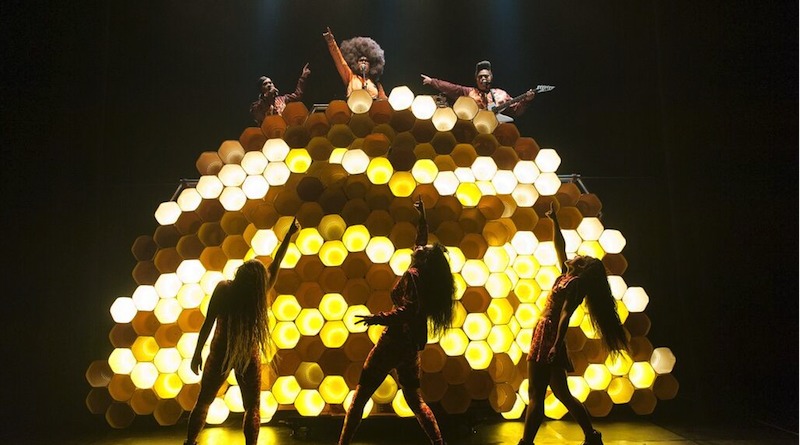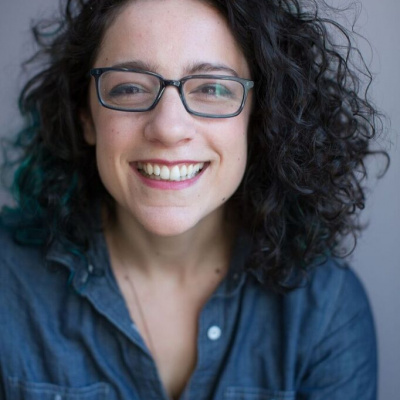The Queens of Hot Brown Honey Are Finally Centerstage
Step into the Hive: the first thing you might notice on theHot Brown Honey stage is the giant honeycomb set piece– a majestic light-up structure that serves as DJ booth and stage backdrop. While finding your seat, you’ll be greeted by one of the six Honeys themselves, warmly welcoming you to the show while wearing yellow and brown tracksuits (that sport the show’s title on the back) and large afro-pick shaped earrings.
The six First Nations women (from Aboriginal Australian, Samoan, Tongan, Indonesian and South African backgrounds) ofHot Brown Honey have no interest in a fourth wall (or any divisive structure for that matter). Both the show’s director (and performer), Lisa Fa’alafi and performer Ofa Fotu welcome the audience before the show officially begins, and both proudly declare into the microphone, “This is live theatre, we can see you!” as a reminder that our passivity won’t get us very far in this world. At Hot Brown Honey the audience does better when we lose the observer etiquette, root into our bodies, and open our ears, our hearts, and our voices.
“Repetition is key”
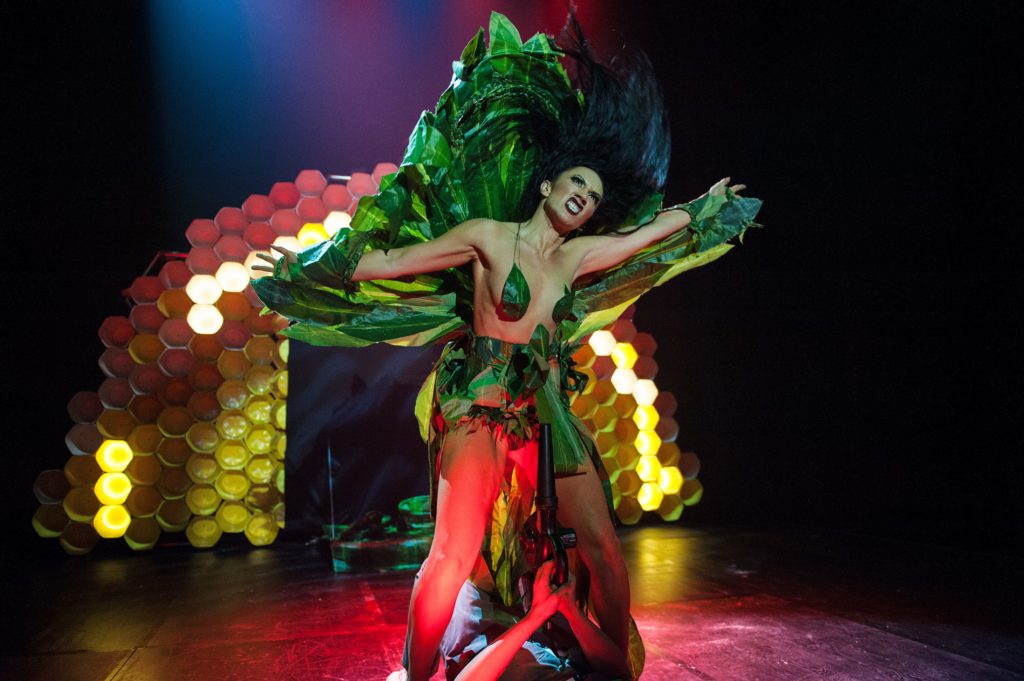
Call and response is one of the pillars of the show’s vibrant and inclusive structure. Its use both ensures accountability that the audience is listening while also giving us permission to dance and shout in celebration with the performers. This conversation is led by The Queen Bee atop the honeycomb, music director and co-creator of the show, Kim “Busty Beatz” Bowers. Bowers guides us through the night embodying roles as DJ, clown, preacher, teacher, and social justice warrior simultaneously. Her dynamic soundtrack is full of bass, and the steady beats from a variety of music genres create a vital pulse throughout the show.
Themes of decolonization, dismantling stereotypes, toppling the patriarchy, examining privilege, and the amplification of marginalized voices are also pillars of the Hive. So is the prioritization of fun and spectacle. The show begins with a playful and extravagant burlesque number featuring giant sunflower fans and tear-away shirts filled by the image of Oprah Winfrey’s face, that ends with the honeys stripping away jumpsuit after jumpsuit until they are left in maid costumes. Bowers reads a quote, proclaiming, “The problem with stereotypes is not that they are untrue, but that they are incomplete. They make one story become the only story.” She tells each of the five Honeys onstage, “You are not the maid. You are not the maid. You are not the maid. You are not the maid. You are not the maid,” and as the lights blackout on them, spotlit and alone she concludes, “and I am definitely not. The fucking. Maid.” Throughout the show, Bowers echoes this mantra, with the reminder that to liberate oneself from oppressive belief structures, “repetition is key.”
Beyond Categorization
The genre-defying show, which includes highly theatrical burlesque, circus, musical, and dance numbers has lighting design to rival a celebrity stadium concert and stunning costume design full of burlesque design surprises.Hot Brown Honeyuses all of its available theatrical vocabularies to mock the fetishization of “otherness” while calling on First Nations peoples, people of color, women, and gender non-binary people to make their voices heard. Throughout the show we are reminded to “make noise.” It’s easy to interpret the prompt as simply a cue to cheer for the raucous and impressive performances, but it is also a reminder for oppressed voices to refuse silencing and to speak up.
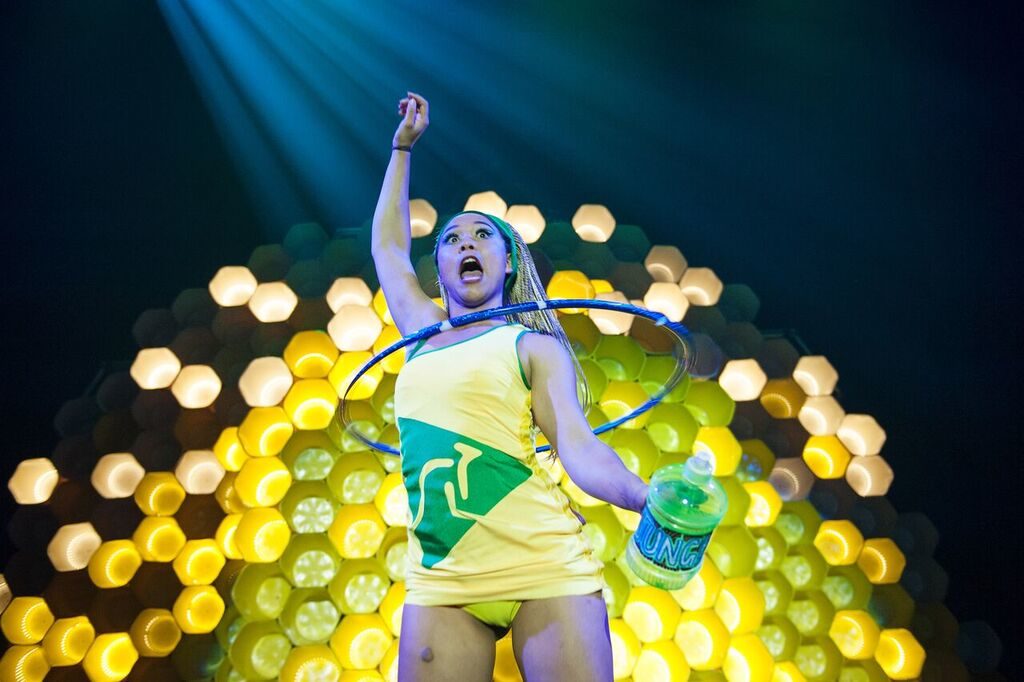
In a 2016 interview on the Australian podcast Women On the Line, Bowers explained the importance of creating legacy for femmes of color speaking up: “I feel for me, especially living in Australia and growing up in Australia there weren’t those role models- or even coming from the African diaspora too — I go, ‘Where are the women that came before me? Where were they?’ And what happened was they were symbolically annihilated basically. They weren’t allowed to be in shows, they weren’t allowed to follow the pathway that they should’ve… [Our show] is about making noise. You make noise because you’re here. It’s about visibility.”
Lisa Fa’alafi’s director’s note states: “Too often we are portrayed as the savage, the maid, the victim, the perpetrator, but tonight we defy these labels. We ask you to celebrate with us. Celebrate all that we are.”
The direction of the show certainly amplifies this celebratory intention. The many colorful and intricately constructed costumes (designed by Fa’alafi and Colleen Sutherland) all carry narrative functions. A bikini with the print of the Australian flag reminds us that symbols of colonization exist in seemingly innocuous places, while conversely beatboxer Hope Haami wears tuxedos and tracksuits, proudly reminding us that being femme isn’t synonymous with wearing a dress. Each performer has at least one featured act that highlights their unique specialty skills (including hula hoops, singing, beat boxing, aerial strap loops, burlesque and tumbling) while moving the show’s message forward, but more often than not many of them are onstage together in group numbers. The group choreography (also by Fa’alafi) draws from movement in the artists’ cultural traditions as much as hip hop and variety traditions, bridging all of the dynamic backgrounds on the stage. The energetic dance scenes are layered with Bowers offering some cultural awareness and critical discourse over familiar club tracks– further emphasizing that fun and wokeness are not mutually exclusive.
Raging with Love
The messaging ofHot Brown Honeyis never hateful or violent, rather it is full of love, humor, and joy. Late in the show, the honeys repeat, “We rage because we love!” reminding us that revolution can come out of celebration as much as it can come from trauma. “When I say ‘Love,’ you say ‘Respect!’” commands Bowers at one point in the performance. The words scroll as an enormous crawl across the lights of the Hive’s honeycomb facade, and a vibrant array of enthusiastic audience hands are in the air shouting back “Respect!” each time Bowers offers a “Love!” in our direction.
I asked director Lisa Fa’alafi how it’s been as a company of all femmes of color and playing some of the biggest cultural centers in the world’s biggest, and dominantly white, cultural cities. The show has been touring for five years now, and has graced The Sydney Opera House in Australia, London’s Southbank Centre, and dozens of other high profile venues around the world. It hasn’t been easy, and she describes how her work with Bowers (a collaboration that has been going on for 15 years) wasn’t particularly welcomed by mainstream programmers early on: “Often our work kept getting programmed on the fringes… it was always in the ‘other’ programming, it was always in the ‘ethnic season.’ We could never be programmed outright for just being excellent.” The plan forHot Brown Honey all along has been to make celebratory space for femmes of color in large theatre spaces that are traditionally less inclusive of these stories and voices. And make no mistake, this show is simply excellent.
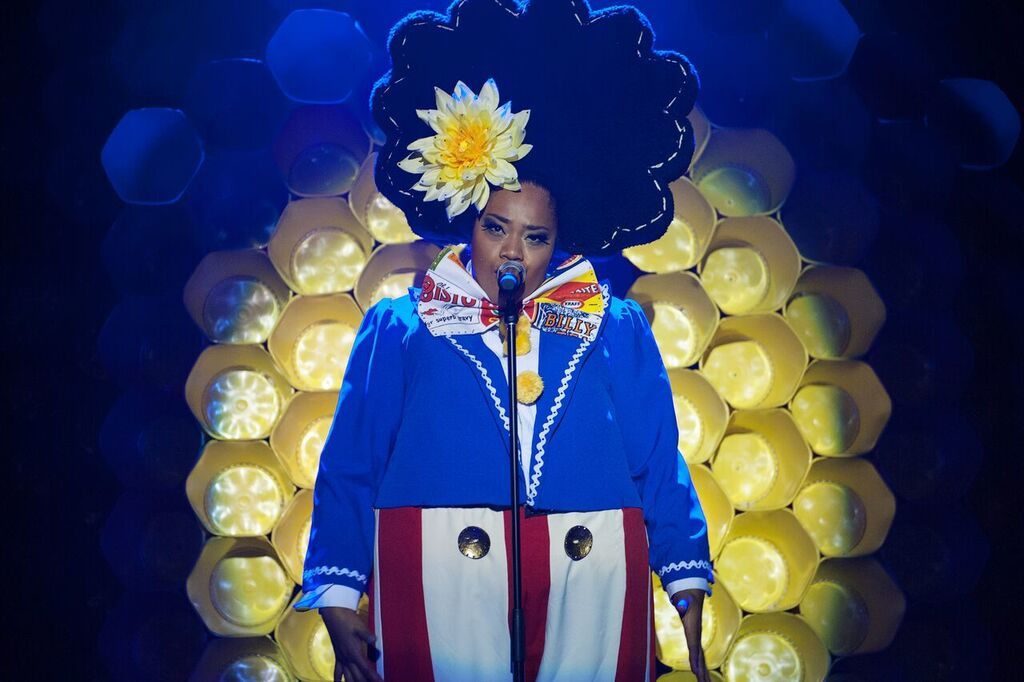
“Each time we’ve had one of these venues we’ve had to prove ourselves. It’s like ‘We’re not sure who will come,’ and we have to come to the table with all of our connects, with all of our strategies for marketing– instead of them, who have a full time marketing department, thinking outside of the box… we have to prove people will come. So then they’ll give us a short season, and it’ll sell out before we get there. And then they’re like ‘Oh!” … it’s been exhausting. The last five years have beenamazingbut it’s so true we have to work so much harder– and that’s annoying–but we also know that we can see part of the legacy with other doors being opened to other people.”
Amidst all of the partying in the show’s energetic, dense (and very fast) 75 minutes, the audience is left with a lot to discuss and unpack. Countering uproarious numbers like the show-stopping “Don’t Touch My Hair” are sobering moments that call attention to racial profiling and sexual violence, like the the aerial strap loops act right before the show’s finale. The strap loops are rigged on a bungee pack, and the effect creates a sense of reckless chaos to which aerialist Crystal Stacey must always either fight or surrender. Stacey’s aerial technique and control in the air is excellent, but the metaphor of being at the mercy of an outside force raises the stakes of the compelling scene.
As I stood in the theatre lobby of NYU’s Skirball Center (followingHot Brown Honey’s American premiere) with friends, colleagues, and strangers, an energy of joy and gratitude radiated all around. A merch table in the corner was set up with the reminder, “The revolution cannot happen without childcare!” and boasts that the proceeds of the show’s merch help support the childcare expenses of the two mothers who are part of the cast.
Hot Brown Honey ended like it began with the performers returning to the aisles of the theatre, dancing and inviting the audience into dialogue after the show. “We always knew that for us the conversations after the show were the most important part,” Fa’alafi told me. Sharing space together in the foyer after the show, it’s clear that the Hive is not confined to the prosceniums this infectiously fun and powerful show has graced in its multi-year tour de force run. In the words of one of the show’s “mothers,” twentieth-century black, queer, feminist poet and activist Audre Lorde, “Revolution is not a one-time event. It is becoming always vigilant for the smallest opportunity to make a genuine change in established, outgrown responses; for instance, it is learning to address each other’s difference with respect.” The Hive is everywhere, and it’s this humble reviewer’s honor to buzz on behalf ofHot Brown Honey and encourage anyone, anywhere this show is playing, to respond to the call of these fierce and brilliant femmes.
Related content: A Second Coming–Australia’s Briefs Factory Confronts NYC with Queer Circus, Drag & Burlesque
All photos provided courtesy of Hot Brown Honey...
Do you have a story to share? Submit your news story, article or press release.

